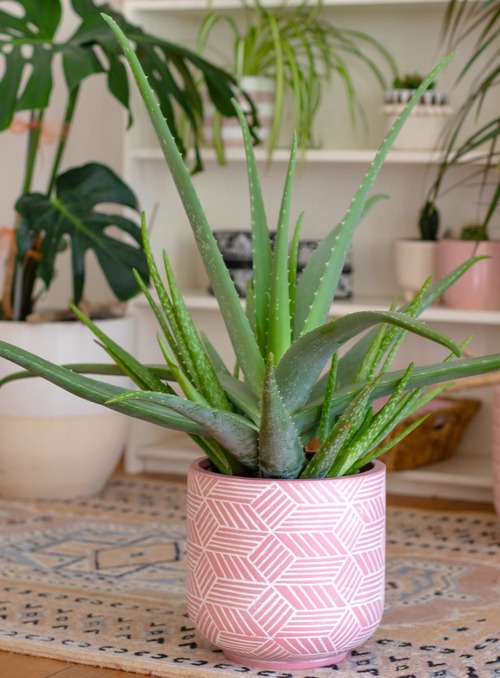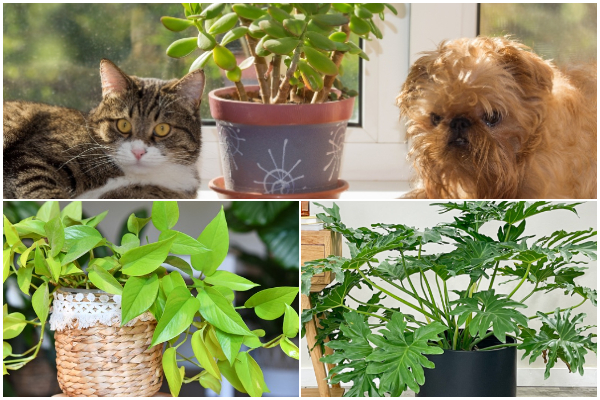Your kitchen is one of the most active rooms in the house, where meals are prepared and conversations flow. Adding houseplants to this space not only enhances its aesthetic appeal but also brings a host of benefits, from purifying the air to promoting a calm and relaxing atmosphere. However, the kitchen’s unique conditions, such as fluctuating humidity levels, heat from cooking appliances, and varying light, require houseplants that are hardy and adaptable. In this article, we’ll explore 7 of the best houseplants to brighten up your kitchen while thriving in these conditions.
1. Herbs (Basil, Mint, Rosemary, and Thyme)
Herbs are a kitchen essential, providing fresh flavors to your cooking while acting as aesthetically pleasing houseplants. Placing potted herbs in your kitchen allows easy access to fresh, aromatic ingredients while also adding greenery to the space. They thrive in kitchen environments, benefiting from the sunlight and moisture from cooking.
Herbs serve a culinary function while also being decorative, adding lush green leaves and fragrant aromas to your kitchen. Many herbs, such as basil, mint, rosemary, and thyme, are relatively easy to grow in pots and can thrive on a sunny kitchen windowsill. Some herbs, like mint, help to cleanse the air and repel pests, which is an added bonus in the kitchen.
Care Tips:
- Place your herbs in a bright spot with plenty of sunlight, such as on a windowsill or near a well-lit area of the kitchen.
- Water them regularly but avoid waterlogging the soil. Most herbs prefer moist but well-draining soil.
- Harvest your herbs frequently to encourage growth and prevent them from becoming too leggy.
2. Aloe Vera
Aloe vera is a hardy succulent that is perfect for the kitchen. Not only does it look attractive with its thick, fleshy leaves, but it also has practical uses. The gel inside the leaves can soothe burns, which is especially helpful in a kitchen environment where minor burns can happen while cooking.
Aloe vera’s soothing gel is a natural remedy for burns, cuts, and skin irritations, making it a practical plant to have in the kitchen. They requires very little attention, making it perfect for busy kitchens. It thrives on neglect and doesn’t need frequent watering. They also help to remove toxins like formaldehyde from the air, keeping your kitchen environment healthier.
Care Tips:
- Aloe vera prefers bright, indirect sunlight, so place it near a kitchen window that receives plenty of natural light.
- Water your aloe vera sparingly. Let the soil dry out completely between waterings, as it stores water in its leaves and doesn’t need constant moisture.
- Ensure it’s planted in well-draining soil to prevent root rot.
3. Spider Plant
Spider plants are one of the most popular houseplants due to their adaptability and hardiness, making them an excellent choice for kitchen spaces. Their arching green-and-white striped leaves add a vibrant, fresh look to any room, and they’re known for their air-purifying qualities.
Spider plants are effective at removing toxins such as formaldehyde, carbon monoxide, and other impurities commonly found in the air of busy kitchens. They can tolerate low-light conditions, making them perfect for kitchens without direct sunlight. These plants are tough and forgiving, which is ideal for a space where environmental conditions fluctuate frequently.
Care Tips:
- Spider plants do best in bright, indirect light, but they can also tolerate low-light conditions, making them suitable for various kitchen setups.
- Water them when the soil starts to dry out but avoid overwatering, as spider plants don’t like soggy soil.
- Trim any brown tips off the leaves to maintain a neat appearance, and repot the plant if it becomes root-bound.
4. Snake Plant
Snake plants, also known as mother-in-law’s tongue, are incredibly low-maintenance houseplants that thrive in almost any environment, making them ideal for kitchens. Their stiff, upright leaves with distinct green and yellow patterns add a modern and bold touch to kitchen décor.
Snake plants can withstand neglect, low light, and varying temperatures, making them perfect for the kitchen, where the environment can change frequently. They are known for their ability to filter out toxins like formaldehyde, benzene, and trichloroethylene, improving air quality in your kitchen. The bold, vertical lines of the snake plant’s leaves bring a sleek, modern look to the kitchen.
Care Tips:
- Snake plants can tolerate low to bright light, but they prefer indirect sunlight. Place them near a window or in a bright corner of the kitchen.
- Water them sparingly. Snake plants thrive on infrequent watering, and overwatering can lead to root rot.
- Use well-draining soil to prevent the roots from sitting in water.
5. Pothos
Pothos, often referred to as Devil’s Ivy, is a versatile and easy-to-grow plant that can adapt to a variety of light conditions, making it perfect for kitchen spaces. Its trailing vines with heart-shaped leaves add a lush, tropical vibe to the room.
Pothos can grow in low, medium, or bright indirect light, making it suitable for kitchens with less natural light. It’s an easy plant to care for, making it a great choice for kitchens where time is often limited. It is known for its ability to remove common household toxins, including formaldehyde and benzene, making your kitchen environment healthier.
Care Tips:
- Pothos prefers indirect light, but it can tolerate lower-light conditions, so you can place it in various spots around your kitchen.
- Water your pothos when the top inch of soil is dry. It can handle occasional periods of neglect but don’t let the soil completely dry out.
- Prune the vines if they grow too long or leggy, and propagate the cuttings to grow new plants.
6. ZZ Plant
The ZZ plant is another hardy houseplant that is perfect for the kitchen. With its glossy, deep green leaves and upright growth habit, the ZZ plant adds a modern and polished touch to any kitchen. It’s tolerant of low light, drought, and even neglect, making it an excellent choice for busy households.
The ZZ plant can survive with very little care, making it perfect for kitchens where daily plant maintenance might be a challenge. It can thrive in low-light conditions, making it suitable for kitchens without much natural light. It is effective at removing toxins from the air, improving the indoor environment of your kitchen.
Care Tips:
- ZZ plants do best in low to medium indirect light, so place them away from direct sunlight, such as on a kitchen counter or a shelf.
- Water infrequently, allowing the soil to dry out completely between waterings. Overwatering can lead to root rot.
- Wipe the leaves occasionally to keep them shiny and free of dust.
7. Philodendron
Philodendrons are versatile and low-maintenance houseplants that add a touch of lush greenery to your kitchen. With their heart-shaped leaves and ability to adapt to different light conditions, they’re a great choice for kitchen spaces. Philodendrons are available in both vining and upright varieties, giving you flexibility in how you display them.
They can thrive in a range of lighting conditions, from low to bright indirect light, making them perfect for kitchens with varying light levels. They’re easy to care for and forgiving of occasional neglect, making them ideal for a busy kitchen environment. They are excellent at removing harmful chemicals from the air, such as formaldehyde.
Care Tips:
- Place your philodendron in bright, indirect light, but it can tolerate lower light levels as well.
- Water when the top inch of soil feels dry to the touch. Be careful not to overwater, as philodendrons prefer slightly dry conditions.
- Regularly prune any yellowing leaves to encourage healthy growth.
















Leave A Comment